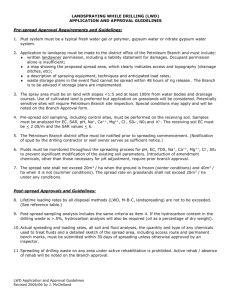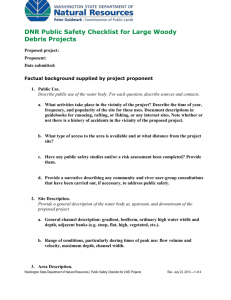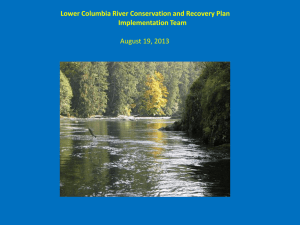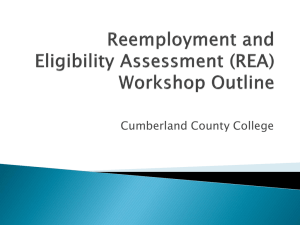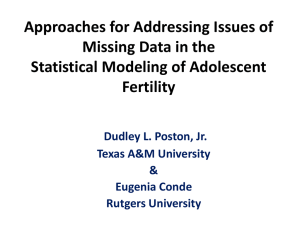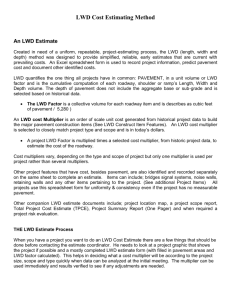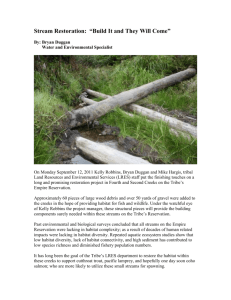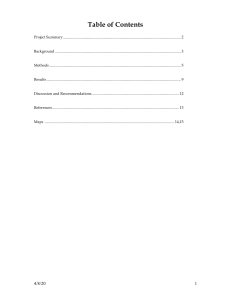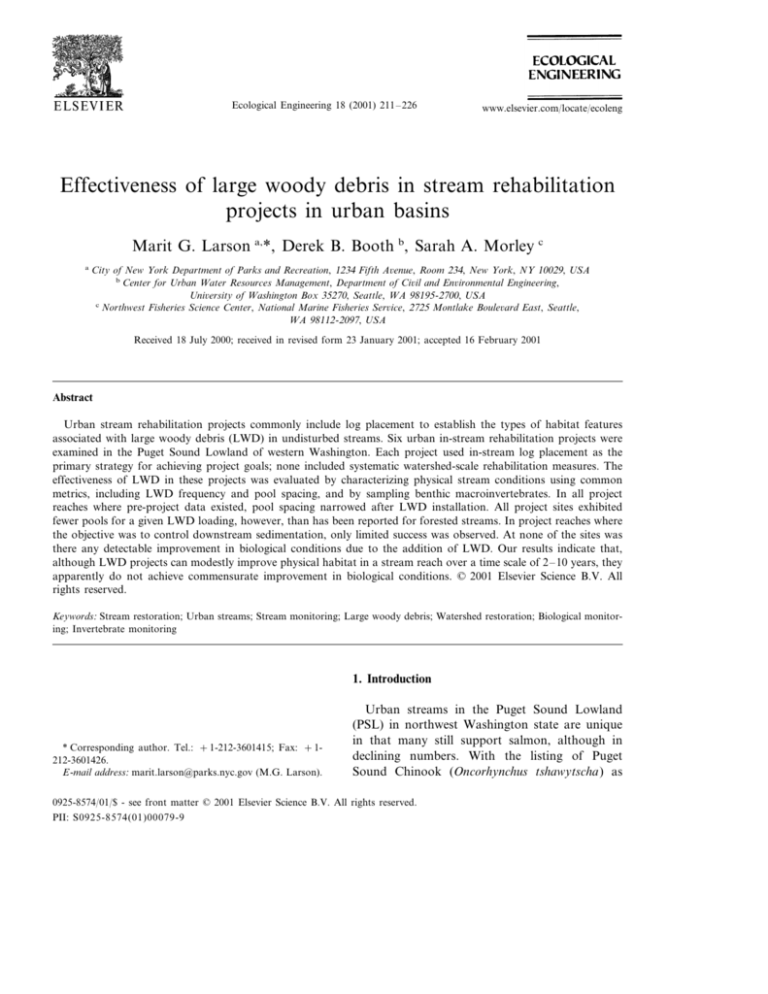
Ecological Engineering 18 (2001) 211– 226
www.elsevier.com/locate/ecoleng
Effectiveness of large woody debris in stream rehabilitation
projects in urban basins
Marit G. Larson a,*, Derek B. Booth b, Sarah A. Morley c
a
City of New York Department of Parks and Recreation, 1234 Fifth A6enue, Room 234, New York, NY 10029, USA
b
Center for Urban Water Resources Management, Department of Ci6il and En6ironmental Engineering,
Uni6ersity of Washington Box 35270, Seattle, WA 98195 -2700, USA
c
Northwest Fisheries Science Center, National Marine Fisheries Ser6ice, 2725 Montlake Boule6ard East, Seattle,
WA 98112 -2097, USA
Received 18 July 2000; received in revised form 23 January 2001; accepted 16 February 2001
Abstract
Urban stream rehabilitation projects commonly include log placement to establish the types of habitat features
associated with large woody debris (LWD) in undisturbed streams. Six urban in-stream rehabilitation projects were
examined in the Puget Sound Lowland of western Washington. Each project used in-stream log placement as the
primary strategy for achieving project goals; none included systematic watershed-scale rehabilitation measures. The
effectiveness of LWD in these projects was evaluated by characterizing physical stream conditions using common
metrics, including LWD frequency and pool spacing, and by sampling benthic macroinvertebrates. In all project
reaches where pre-project data existed, pool spacing narrowed after LWD installation. All project sites exhibited
fewer pools for a given LWD loading, however, than has been reported for forested streams. In project reaches where
the objective was to control downstream sedimentation, only limited success was observed. At none of the sites was
there any detectable improvement in biological conditions due to the addition of LWD. Our results indicate that,
although LWD projects can modestly improve physical habitat in a stream reach over a time scale of 2 – 10 years, they
apparently do not achieve commensurate improvement in biological conditions. © 2001 Elsevier Science B.V. All
rights reserved.
Keywords: Stream restoration; Urban streams; Stream monitoring; Large woody debris; Watershed restoration; Biological monitoring; Invertebrate monitoring
1. Introduction
* Corresponding author. Tel.: + 1-212-3601415; Fax: +1212-3601426.
E-mail address: marit.larson@parks.nyc.gov (M.G. Larson).
Urban streams in the Puget Sound Lowland
(PSL) in northwest Washington state are unique
in that many still support salmon, although in
declining numbers. With the listing of Puget
Sound Chinook (Oncorhynchus tshawytscha) as
0925-8574/01/$ - see front matter © 2001 Elsevier Science B.V. All rights reserved.
PII: S0925-8574(01)00079-9
212
M.G. Larson et al. / Ecological Engineering 18 (2001) 211–226
‘endangered’ under the federal Endangered Species Act in 1999 — the first time a species has
been listed within a major metropolitan area — a
greater importance has been placed on reversing
urban impacts on waterways in the PSL. For
this reason, engineered projects now being designed and constructed in urban streams are increasingly required to benefit salmon habitat, even
if they are motivated primarily by more traditional concerns such as flood control or property
protection.
In-stream rehabilitation projects are commonly
built in response to problems that result from
both local sources and diffuse watershed degradation. Local problems, such as an improperly sized
culvert, are relatively easily identified and corrected. Reversing the consequences of watershed
degradation, such as channel widening and incision, is much more difficult because conditions
that led to stream degradation usually remain
unchecked. Yet, because of numerous recognized
problems on streams in urban or urbanizing
basins, the interest of local communities in restoring the amenities these streams provide (MacDonald, 1995; Riley, 1998), and the relative ease and
economy of site-specific in-stream work, large
amounts of money are being spent on in-stream
projects.
While the number of urban stream restoration
projects is increasing across the nation, comparatively few examples of monitoring programs designed to measure the success of such efforts are
documented (Kerschner, 1997). In western Washington, salmon recovery is an objective of the
majority of rehabilitation projects, yet very rarely
are salmon or any other element of stream biota
directly monitored to assess restoration success.
Of over 300 rehabilitation projects installed over
the past decade in urban areas around the Puget
Sound Lowland, less than 5% were evaluated with
any sort of biological or habitat suitability data
(Kropp, 1998).
This study investigates the effectiveness of one
common technique, placement of in-stream large
woody debris (LWD), to reverse local effects of
watershed degradation in the absence of any systematic watershed-scale approaches to rehabilitation. To accomplish this, six stream rehabilitation
projects in western Washington that employ
LWD were examined with the objective of answering the following questions.
Does in-stream placement of LWD produce
physical channel characteristics typical of
streams in less disturbed watersheds?
Does biological condition improve immediately
downstream of LWD addition?
How can LWD project designs be improved?
Does watershed disturbance exert greater control over physical and biological recovery of
the channel than the local in-channel conditions addressed by added LWD?
1.1. Impacts of urbanization
Because of its permanence, urbanization poses
a particularly ominous obstacle for stream protection and rehabilitation. The process of urbanization usually results in irreversible changes to the
land surface and drainage pattern by increasing
the impervious area, reducing vegetation cover,
compacting soil, reducing areas of depression
storage, concentrating and re-routing runoff, and
straightening and piping streams. These changes
cause a progressively greater fraction of precipitation to enter the channel rapidly as Horton overland flow (Leopold, 1968; Graf, 1975; Hollis,
1975). Particularly in geologic regions such as the
PSL, where overland runoff is rarely generated
and subsurface flow predominates, these changes
can alter stream channels (Harr, 1976; Booth,
1990, 1991). Direct alterations to channels and
riparian corridors include removing bank vegetation, clearing woody debris from streams, armoring stream beds and banks, straightening
channels, reducing floodplain storage, and diverting extensive stretches of streams through culverts. Removing LWD, in particular, can modify
channel morphology and increase sediment discharge, and has led to the widespread loss of
once-prevalent wood in urban channels (fore example, Booth et al., 1997; Horner et al., 1997).
1.2. The use of LWD in channel enhancement
LWD plays prominent roles in regulating morphology and habitat in Pacific Northwest chan-
M.G. Larson et al. / Ecological Engineering 18 (2001) 211–226
nels, from steep and narrow headwater streams to
wide low-gradient rivers. These functions make it
a critical component of current stream and river
restoration, and enhancement efforts. The effects
of LWD on moderate-gradient streams (0.5– 4%
slope) with bankfull widths of about 4– 40 m have
been studied in greatest detail. The steeper of
these channels, dominated by riffle and glide features, are classified as ‘plane-bed’ by Montgomery
and Buffington (1998). Lower gradient streams
commonly display regularly alternating riffles and
pools in a meandering planiform. The transition
from ‘plane-bed’ to these flatter ‘pool-riffle’ channels, under a particular sediment-supply and flow
regime, can be controlled by the presence of obstructions, notably LWD, that form scour pools,
bars, sediment storage sites, and steps in channels
that would otherwise maintain a relatively flat
and uniform bed. In these channels, LWD can
influence bank stability, pool and bar formation,
sediment retention, and grade (Montgomery et
al., 1995; Beechie and Sibley, 1997; Nelson, 1998).
The reported effects of re-introducing LWD (or
other physical habitat structures) to a channel,
particularly when watershed conditions have not
been simultaneously addressed, is ambiguous.
Several studies have reported that, at least in the
short term, such habitat elements as pools, substrate for fish spawning or invertebrate colonizers,
and cover for fish can be improved using instream structures alone (House and Boehne, 1986;
Gortz, 1998; Hilderbrand et al., 1998; Shields et
al., 1998). Some studies have shown that macroinvertebrate community structure changes and diversity increases when structures are added
(Hilderbrand et al., 1997; Gortz, 1998), but they
also report ambiguous responses in fish usage
(Shields et al., 1998). In forested watersheds, studies have reported higher fish counts after habitat
structures were installed in forested streams
(House and Boehne, 1986; Crispin et al., 1993). In
contrast, a comprehensive evaluation of in-stream
rehabilitation projects (Frissell and Nawa, 1992)
documented a high incidence of structure failure
after floods of no more than a 10-year recurrence
interval, and it emphasized the local and largely
short-term benefits of LWD addition. House
(1996) found similar shortcomings of in-stream
213
structures. No studies have yet evaluated whether
wood placed in urban streams can provide the
range of functions observed in natural streams,
such as increasing organic matter retention and
attenuating the geomorphic effects of high flows.
2. Approach and methods
2.1. Study sites
Six in-stream rehabilitation projects were chosen for this study based on their location in
watersheds with urban development, their use of
in-stream log placement as a primary strategy for
achieving local rehabilitation goals, and their inclusion of fish habitat enhancement as an objective (Fig. 1). The effectiveness of LWD in these
projects was evaluated according to criteria for
physical improvements, for biological response,
and for meeting stated design performance
standards.
The six evaluated projects lay in physically
similar watersheds but with widely different levels
of human disturbance (Table 1). But for the use
of anchored LWD (i.e. buried or cabled) in the
most developed basins, individual project characteristics were otherwise unrelated to watershed or
stream characteristics. The streams in this study
all had perennial flow and were classified as alluvial plane-bed or pool-riffle channels (Montgomery and Buffington, 1998).
The six rehabilitation projects included examples of both anchored and unanchored LWD, as
well as different types of LWD, such as smooth
logs, root wads, and tops of trees. Five of the
projects had been built within 4 years of this
study; the project at Forbes Creek was 10 years
old (Table 2). Project lengths ranged from 210 to
430 m, except at Soosette Creek where wood was
placed over a 1430 m long reach. Specific project
objectives varied. However, all but one project
identified ‘habitat enhancement’ as a primary or
secondary goal, and most had some flood and
sediment control objective. The degree to which
the stream channels were constrained by residences, roads, or bank armor varied greatly between projects.
214
M.G. Larson et al. / Ecological Engineering 18 (2001) 211–226
2.2. Analysis
Development intensity in the watershed area
contributing to each project was determined from
geographical information system (GIS) land-cover
data layers based on 1995 Landsat satellite imagery, classified by King County Land and Water
Resources Division (Jeff Burke, personal communication, 1998) at 30 m resolution. For this analysis, land cover was considered developed if
classified as ‘high-intensity’, ‘medium-intensity’,
or ‘low-intensity’ development; or ‘bare rock/concrete’, ‘bare ground/asphalt’, or ‘recently cleared’
land. The percentage of developed land in each
basin upstream of the downstream end of the
project was calculated using ArcView GIS.
To determine whether projects were successful
in improving physical and biological conditions,
monitoring was conducted in reaches at and upstream of where LWD was added. At the three
projects where pre-project physical data existed
(Laughing Jacobs, Soosette, and Swamp Creeks),
pre- and post-project stream conditions were compared. For projects without pre-project data,
post-project conditions were compared with data
reported in the literature for Puget Sound Lowland streams (Montgomery et al., 1995; May,
1996; Karr and Chu, 2000) and/or to reaches
upstream of each project. At most sites, the upstream reaches varied somewhat from pre-project
conditions due to differences in valley width,
slope, or encroachment, but all were geomorphically similar.
Two sections of stream, at least 20 times the
bankfull width, were surveyed in the project and
just upstream of the project on each stream. All
pieces of wood greater than 10 cm diameter and
longer than 1 m in any portion of the bankfull
channel were counted, based on criterion for
LWD used by Montgomery et al. (1995), Greenberg (1995), May (1996). Root wads greater than
0.02 m3 in volume were also counted. The diameter and length of every piece was estimated; every
five to ten pieces the lengths and widths were
Fig. 1. Study location: western Washington state and the six rehabilitation project watersheds.
M.G. Larson et al. / Ecological Engineering 18 (2001) 211–226
215
Table 1
Watershed and stream characteristics
Forbes
Thornton
Stream characteristics
Average bankfull width (m)
Bed slope
Median grain size (mm)
Upstream drainage (km2)
3.5
0.037
14
3.5
5.4
0.006
18
25.4
Percent upstream de6elopment
Watershed (%)
Riparian buffer (100 m) (%)
82
70
93
75
Basin relief (m)
Basin gradient (relief/basin length)
45
0.009
45
0.005
a
Swamp
Hollywood Hills
Laughing Jacob’s
Soosette
10.4
0.005
14
53.6
4.1
0.046
11
2.2
6.4
0.028
39
11.1
8.7
0.019
51
13
72
47
62
44
52
43
58
34 (45)a
50
0.002
40
0.008
40
0.008
150
0.003
Percent development in riparian buffer of the upstream end of the project.
measured with a tape to calibrate the visual estimate. ‘Key pieces’ were also identified; they are
those pieces of LWD defined as being independently stable within the bankfull channel (i.e. not
held or trapped by other material) and retaining
or having the ability to retain other LWD
(WFPB, 1997). The position of LWD in the project reaches with respect to the directions of flow
was sketched in the field, as was any obvious
association with bank scour.
Where pre-project data were available, the
movement of LWD in the project reaches was
estimated. Photographic documentation, sketched
‘as-built’ positions of logs, notes from longitudinal surveys, or notes on aerial photographs, were
used to ascertain the mobility of the wood. To
evaluate the flow conditions under which any
documented LWD movement occurred, the magnitude of the largest flow after the project installation was determined from available gauges.
Residual pool depths (RPDs), the difference
between depth of water in the pool and at the top
of the downstream riffle (Lisle, 1987), were measured in the field and calculated from longitudinal
thalweg surveys. Only depressions with a RPD of
at least 25% of the bankfull depth and a minimum
pool length at least 10% of the bankfull width
were included in the final tally of pools (Montgomery et al., 1995). Pre-project information on
pool numbers was taken from the Fish Habitat
Relation surveys conducted by the King County
Water and Land Resources Division at three of
the projects. These counts were converted to an
average pool spacing over each measured reach
and expressed as the distance between pools in
units of bankfull channel widths. This allowed
direct comparisons between streams in this study
and those in previously published studies.
The influence of LWD on the formation of
pools was determined by field observation. Two
categories were identified: pools formed by wood
and pools formed by some other mechanisms
(such as scour around a boulder or lateral scour
against an armored bank). The number of pieces
of wood associated with a given pool was also
counted.
The influence of LWD on in-channel sediment
storage was described by characterizing bars as
either ‘self-formed’ if no LWD was present, or
‘associated with LWD’ if they were covered with
or located immediately upstream or downstream
of LWD. Where LWD was trapping sediment, the
depth of the stored sediment was estimated by
measuring the height of the step created by the
LWD, and the total volume was estimated assuming the sediment was deposited as a wedge behind
the LWD. The overall volume of sediment in the
reach was estimated by measuring the total volume of all alluvial bars in the channel.
The influence of LWD in controlling grade in a
given reach was estimated using a longitudinal
profile of the channel thalweg. Steps in the longitudinal profile occurring at locations of LWD
were specified in the survey. The change in the
216
Project characteristics
Year constructed
Project length (m)
LWD placement
Number of pieces of LWD
added
Approximate cost ($/m)a
Project objecti6es
Flood control
Sediment/erosion control
Habitat enhancement
a
Anchored LWD
Unanchored LWD
Forbes
Thornton
Swamp
Hollywood Hills
Laughing Jacob’s
Soosette
1988
210
Cabled and in
weirs
18
1997
280
Cabled and in
weirs
25
1997
370
Anchored as
deflectors
48
1996
240
Unanchored, by
crane
300
1995
430
Unanchored, by
crane
80
1994
1430
Unanchored, by
helicopter
280
$160c
$580d
$120c
$280c
X
X
X
X
X
X
X
X
$350b
X
X
X
NA
X
X
X
X
Costs based on preliminary estimates of construction costs divided by project length.
Source: Parametrix (1988).
c
Source: KCDNR (1995, 1996, 1997).
d
John Bethe, KCDNRl, personal communmication.
b
M.G. Larson et al. / Ecological Engineering 18 (2001) 211–226
Table 2
Project characteristics
M.G. Larson et al. / Ecological Engineering 18 (2001) 211–226
water surface elevation at LWD steps were
summed and divided by the total drop in elevation over the reach to yield the percent of the
elevation change controlled by LWD.
Biological condition at project sites was assessed with the benthic index of biological integrity (B-IBI) (Karr and Chu, 1999). The B-IBI is
composed of ten metrics of taxa richness and
evenness, disturbance tolerance, and life history
attributes of benthic invertebrates. The B-IBI
ranges in value from 10 to 50 and can detect five
categories of watershed condition, from undisturbed to highly degraded (Doberstein et al.,
2000).
Benthic invertebrates were collected at four of
the rehabilitation projects. Monitoring sites were
located immediately upstream and downstream of
each restoration project. These paired sites were
selected to be as similar as possible in all regards
except for the presence of added LWD. All but
Hollywood Hills were sampled in 1998, and two
of the more recently completed projects (Swamp
and Laughing Jacob’s Creeks) were re-sampled in
1999.
Invertebrates were collected from each site in
September when flows are typically stable and
taxa richness is high (Fore et al., 1996). At each
217
site, a Surber sampler (500-mm mesh, 0.1 m2
frame) was used to collect three samples along the
mid-line of a riffle (see Morley, 2000). Insect
nymphs and larvae were identified to genus where
practical; non-insect taxonomic identification
varied from family to phylum. Following procedures first for fish (Karr et al., 1986), and then for
invertebrates (Kerans and Karr, 1994; Fore et al.,
1996), values from each of the ten metrics were
summed to calculate a B-IBI score at each site.
3. Results
3.1. Installed LWD frequency, size, and mobility
LWD frequency was used to compare physical
conditions in-stream and upstream of the project
reach to those of geomorphically similar reference
streams (Fig. 2). The forested reference streams
allowed comparison with pre-urban conditions;
urban reference streams allowed a comparison
with a wider range of disturbed conditions than
represented by the six study sites.
In the study reaches, LWD loadings were
highest — in the range of least degraded urban
streams — in unanchored projects (Fig. 3). Only
Fig. 2. Pool spacing versus LWD frequency in urban and forested streams in northwest Washington state (data from Montgomery
et al. 1995; May 1996).
218
M.G. Larson et al. / Ecological Engineering 18 (2001) 211–226
Fig. 3. Pool spacing versus LWD frequency: comparison over space (project and upstream sites) and time (pre- and post-project).
Forbes, Thornton, and Swamp Creeks have anchored LWD. At the other streams, LWD is not anchored.
one of the streams (Hollywood Hills), however,
had a LWD frequency considered ideal for a
natural stream (Bisson et al., 1987; WFPB, 1997).
At the projects where the wood was anchored,
LWD loadings were lower and typical of moderate to highly degraded urban streams and clearcuts.
The size of added LWD varied greatly between
projects but showed no relationship either to the
size of the project stream or to whether the LWD
was anchored (Fig. 4). In particular, no logs of
sufficient size to be ‘key’ pieces were added to the
widest stream (Soosette) where LWD was not
anchored, or to the widest streams (Swamp)
where LWD was anchored. However, in the
smallest stream, Hollywood Hills, roughly four
times the number of ‘key’ pieces was added than
typically found in forested streams (Bisson et al.,
1987; WFPB, 1997).
At all projects, typically less than one-third of
the added LWD came in contact with the lowflow channel or obstructed at least one-third of
the channel width. Where LWD was anchored, as
at Swamp Creek, or was large, as at Hollywood
Hills, a higher fraction of the LWD was in the
low-flow channel and did obstruct flow. Where
LWD was the most mobile (at Soosette Creek),
less than one-fifth of the pieces obstructed more
than 30% of the flow.
Since the projects were installed, all experienced
discharges greater than 2-year flows, and three
sites experienced approximately 10-year flows. No
anchored LWD moved at any of the project
reaches and, where over 50% of the unanchored
LWD were key pieces (Hollywood Hills), there
was also no significant LWD movement. In the
projects with unanchored LWD and few or no
key pieces, however, LWD movement was documented. At Swamp Creek, two unanchored logs
were transported out of the project reach. At
Laughing Jacob’s Creek, numerous pieces of
LWD were transported tens of meters downstream, moved across the channel, or abandoned
on adjacent banks. At Soosette Creek, dozens of
smooth logs (as well as logs with branches drilled
into them, ostensibly to mimic the form of ‘real’
trees) moved several tens of meters and several
debris piles re-mobilized.
M.G. Larson et al. / Ecological Engineering 18 (2001) 211–226
3.2. Pool spacing, formation, and depth
Post-project pool spacing was not correlated to
LWD loading (Fig. 3). At three sites (Hollywood
Hills and Laughing Jacob’s and Soosette creeks),
pool spacing was wide compared with the least
degraded urban streams with the same amount of
LWD. Forbes and Swamp creeks, where the
LWD was anchored, had pool spacings most similar to those found in forested and least-degraded
urban streams despite low LWD frequencies. In
the three project reaches where pre-project data
existed, pool spacing narrowed after LWD frequency was added.
Where there was no pre-project information on
pools, the influence of added LWD on pools was
evidenced by the high proportion of pools formed
by added LWD. In each of the project reaches,
50 – 80% of the pools were formed by added
LWD, which was comparable with forested
streams (Montgomery et al., 1995; Beechie and
Sibley, 1997; Nelson, 1998). More of the added
LWD was associated with pools where the LWD
was anchored (30– 70%) than projects where
LWD was unanchored (15– 18%). In forested
streams, 20–40% of LWD was associated with
pools, suggesting that unanchored LWD in urban
channels is not having an identical geomorphic
effect as in undisturbed watersheds. Both types of
LWD addition raised pool numbers, at least
219
slightly, towards those of less disturbed streams.
There was little difference in pool depth between
pools formed by LWD or by other obstructions,
between plunge or scour pools, or between pools
formed by natural LWD or added LWD.
3.3. Sediment storage and grade control
About one-third of the estimated in-channel
sediment storage was associated with LWD at
most sites, although LWD generally did not retain
sediment in the form of a discrete wedge. In all
but one stream, sediment storage associated with
LWD increased by 50–100% where LWD frequency increased. Added LWD contributed most
to grade control (11–23%) on the highest gradient
streams where wood spanned the full width of the
channel, but it contributed little to grade control
on the low-gradient streams. Although several
projects sought to reduce downstream sedimentation by retaining sediment in the reach, only
limited success was observed. LWD can retain
sediment in some channel positions, but this storage was exceeded by high sediment loads.
3.4. Benthic index of biological integrity
Addition of LWD had little demonstrable effect
on biological condition (see Fig. 5). Two projects
had been in place only 1 year when this study was
Fig. 4. Size distribution of added LWD and upstream natural LWD, listed from smallest to largest stream (no LWD was found
upstream at Thornton Creek).
220
M.G. Larson et al. / Ecological Engineering 18 (2001) 211–226
3.5. E6aluation of project design
Fig. 5. Paired B-IBI scores at projects. Scores must differ by at
least four points to conclude that sites are significantly different (Doberstein et al. 2000).
conducted and, although invertebrates rapidly recolonize the benthos following disturbance, this
process may take longer if sources of colonizers
are more distant (Gore, 1885) or if the channel is
still re-equilibrating (Booth et al., 1997). Additional sampling in 1999, however, still showed no
improvement in biological condition. There was
also no detectable improvement in B-IBI scores
when sampling sites were located within, rather
than downstream of, project boundaries.
Local physical channel characteristics, particularly LWD frequency but also pool spacing and
stored sediment upstream of the benthic invertebrate sampling sites, generally were not correlated
with B-IBI. There was only a very weak positive
relationship between B-IBI and extent of bank
erosion, median grain size, or bed stability (indicated by a ratio of critical shear stress to
boundary shear stress: see Olsen, 1997). In contrast, B-IBI was much better correlated with the
level of urban development in the local riparian
zone (Fig. 5), and with overall watershed urbanization. In total, these scores indicate that, although projects several hundred of meters long
may improve some measures of physical habitat
(i.e. pool spacing) in a stream reach over the
evaluated time scales of 2– 10 years, they have had
little influence on the benthic invertebrate
community.
Limited project effectiveness may result when
projects are built with an inadequate design, or if
appropriate designs yield inadequate results. To
weigh these two possibilities, criteria for the design of in-stream structures using LWD were extracted from research on the function of LWD in
forested streams (Table 3). For example, studies
have investigated the size ranges of stable logs at
a given stream width (Bilby, 1984; Bisson et al.,
1987; Hilderbrand et al., 1998), the obstruction
angle associated with pool formation (Lisle, 1986;
Cherry and Bilby, 1989; Gippel et al., 1996), the
relationship between LWD frequency and pool
spacing (Montgomery et al., 1995; Beechie and
Sibley, 1997), the mechanics of log jam stability
(Abbe et al., 1997), and the hydraulics of log
spacing (Gippel et al., 1996).
These ‘design criteria’, inferred from research
on LWD, were compared with conditions at the
six rehabilitation projects to evaluate the success
of each project in meeting them (Table 4). Meeting design criteria, however, is worthwhile only if
those criteria are relevant to attaining actual project objectives. For example, ‘obstruction width’
was an important factor in pool formation at
most sites; when that design criterion was met
(shaded box in Table 4), this objective was also
usually met (+ ). Conversely, ‘key piece frequency’ was also important; at most sites this
criterion was not met (white box, Table 4) and
nor were the associated objectives (−).
Yet most criteria are not sufficient to ensure
that specific project objectives will be met. For
example, the implied criteria for appropriate
cross-bed position and burial of LWD were
achieved at several projects (shaded box, Table 4)
but the project objective of sediment retention
was not (− ). The same was true of log loading,
where even adequate amounts of LWD did not
ensure that all project objectives were achieved.
Finally, some criteria were almost universally
not achieved at the project sites (blank box, Table
4), and yet the associated objectives were usually
still met. This implies that these factors (such as
obstruction angle for pool formation) are not as
important as other design criteria (such as, in this
example, obstruction width).
M.G. Larson et al. / Ecological Engineering 18 (2001) 211–226
4. Discussion
The presented results have allowed us to address the original four questions of this study.
Table 3
Design criteria based on data reported for stable LWD in
natural channels
Description
Inferred LWD design criteria
Value
Obstruction width
Obstructing flow or
Wbka
Obstructing flow
Log spacing
Spacing in any
direction
Downstream distance
Reference
\30%
Lisle (1986)
\10%
Cherry and Bilby
(1989)
\10 log
diameter
\3Wbk
Key piece sizes and
frequency
Wbk = 3–5 m
0.4 m3
Wbk = 6–10 m
0.8 m3
Minimum number of
key pieces per
meter
Wbk = 0–5 m
Wbk = 6–10 m
Minimum number of
key pieces per Wbk
Log loading
Volume per channel
area
Pieces per channel
area
0.13
LWD/m
1 m3
2.4 m3
0.3
LWD/Wbk
0.01
Bisson et al.
(1987)
Bisson et al.
(1987)
Bisson et al.
(1987)
WFPB (1997)
WFPB (1997)
WFPB (1997)
Lisle (1986)
m3/m2
0.035
number/m2
Cross-bed position
Angled to flow; on
bed
Burial and angle
Angled to flow;
mostly buried
Obstruction angle
Angled to flow;
partially elevated
a
Gippel et al.
(1996)
Lisle (1986)
Wbk, Bankfull width.
Montgomery et
al. (1995)
90°
Gippel et al.
(1996)
B30°
Bisson et al.
(1987)
90°
Cherry and Bilby
(1989)
221
4.1. Does in-stream placement of LWD produce
physical channel characteristics typical of streams
in less disturbed watersheds?
In general, LWD is expected to have the greatest influence and range of functions on moderateslope (0.01–0.03) alluvial channels classified
morphologically as pool-riffle or plane-bed, which
includes the streams studied in this study. Particularly in PSL streams, which tend to lack boulder
or bedrock obstructions, and in urban streams,
lacking deep-rooted woody bank vegetation,
LWD is the primary pool-forming mechanism.
Indeed, adding LWD to the urban streams in this
study produced more physical channel characteristics typical of undisturbed streams, such as pools
and sediment storage sites formed by LWD. Pool
habitat and channel complexity also increased in
most of the project reaches. However, any increase in sediment storage and grade control in
these moderate-slope alluvial channels was less
assured. The steepest project reaches studied in
the present paper did not store more sediment,
although LWD did provide more grade control in
the steepest reaches. Stabilizing or retaining sediment to reduce downstream sedimentation and
associated flooding was not accomplished by
adding LWD to the channel.
4.2. Does biological condition impro6e
immediately downstream of LWD addition?
Since fish habitat creation is usually named as
the primary or secondary goal of an in-stream
project utilizing LWD, project monitoring generally focuses on the physical expressions of this
goal. In urban streams, however, structural habitat may be only one of numerous conditions that
are lacking for fish survival, as well as survival of
other aquatic species (such as benthic invertebrates) that are critical links in the aquatic food
web. Since the ultimate goal of habitat restoration
is biological recovery, direct measures of the biota
are needed to determine whether structural measures alone are likely to be sufficient in the face of
watershed-wide disturbances in biogeophysical
processes. For the four projects of this study so
evaluated, B-IBI analysis detected no positive ef-
222
M.G. Larson et al. / Ecological Engineering 18 (2001) 211–226
Table 4
Objectives and LWD design criteria evaluated at project sites
fect on biological condition from the restoration
activities at the time scales sampled. The physical
characteristics in the reach that did change displayed no clear relationship to biological
condition.
4.3. Does watershed disturbance exert greater
control o6er physical and biological reco6ery of
the channel than the local in-channel conditions
addressed by added LWD?
The influence of watershed disturbance on
physical channel response was evident and, in
several instances, overwhelmed any potential
benefits of LWD. High sediment loads buried
some LWD, and high flows transported seemingly
appropriately sized LWD out of the channel or
incised underneath LWD formerly within the
bankfull channel. Biological integrity was not af-
fected by LWD additions, but it was strongly
influenced by overall watershed disturbance. BIBI here varied inversely with the increase in
percent developed land, in full accord with other
regional studies (Karr and Chu, 2000; Morley,
2000).
The degree to which watershed conditions influence project effectiveness varies with specific project objectives. Where the long-term goal of these
habitat enhancement projects is to promote biological recovery, the extent of overall watershed
development strongly limits the success of local
LWD placement projects, independent of project
design or execution. If the creation of more complex bedforms and stable banks is the main objective, watershed degradation can also limit project
success. For example, several LWD structures
intended to scour pools in the most urban streams
in the study instead were filled with sediment, and
M.G. Larson et al. / Ecological Engineering 18 (2001) 211–226
severe bank erosion continued even where vegetation was planted for protection. Where project
objectives included enhancement of riparian vegetation, however, watershed conditions were less
important than local vegetation management.
At the projects in the least degraded watersheds
(52 – 58% development), there was little evidence
that the urban-modified flow pattern were undermining in-stream efforts to enhance the channel.
The undeveloped riparian corridor in the least
developed basins also aided the channel enhancement effort. Trees were naturally recruited
to the stream from these buffers (although commonly not meeting minimum size criteria). Buried
natural LWD and existing vegetation contributed significantly to pool formation and bank
resistance. The deepest pools in several reaches
were formed by formerly buried natural LWD,
and by trees and remnant stumps on the banks.
These features also emphasize the long-lasting
influence of LWD in the channel and on the
floodplain.
223
In our experience, pre-existing project monitoring was often inadequate for evaluating success in
meeting project objectives, as other researchers
have found (for example, Kondolf and Micheli,
1995). Only one of the projects studied here
(Swamp Creek) specified any criteria for evaluating project performance (KCDNR, 1997). Furthermore, the project objectives named at most of
the sites, particularly those related to habitat
quality and complexity or to aquatic species recovery, could not be adequately evaluated using
standard monitoring routines. Pool and LWD
counts, for example, are not sufficient to evaluate
biological or habitat conditions, as we have
shown in the present study (see also Poole et al.,
1997). Biologically, placing logs devoid of bark,
roots, branches, or leaves into urban streams is
not equivalent to natural recruitment, where instream obstructions and cover are but one benefit
of a forested riparian corridor, and the organic
input comes in a variety of forms, sizes, and
configurations (Bilby and Ward, 1989; Gregory et
al., 1991).
4.4. How can LWD project designs be impro6ed?
4.5. Management implications
In the relatively short time that most of the
projects evaluated in this study have been in
place, none experienced complete structural failure. Yet no project met all articulated objectives,
most importantly because those objectives were
too ambitious to be achieve simply by adding
LWD. Where design problems hindered even
modest improvements, the most common shortcomings were ineffective log spacing, failure of
added LWD to remain within the bankfull channel, or placement of LWD too small to affect the
flow. Studies documenting the size distribution
and frequency of LWD found in natural streams
should be used to inform designs in projects
where LWD is added. Particularly where sufficiently large LWD is absent or sparse, anchoring
should be considered to insure that LWD influences the flow in desired locations. When and
where LWD is added should also be guided by an
understanding of local sediment supply and transport conditions, tolerance for LWD movement,
and articulated priorities for LWD function (e.g.
grade control, high flow refuge, direct cover, etc.).
Adding LWD to a degraded urban stream will
not make it perform the same functions as in an
undisturbed stream system. Whereas adding
LWD is likely to achieve a number of specific
objectives, a proliferation of in-stream LWD
projects will not address the multitude of urban
stressors nor ensure habitat protection or biological recovery. Therefore, it is critical to identify the
primary factors causing degradation in a reach, to
evaluate existing channel conditions, and to determine which, if any, objectives could be met with
in-stream enhancement projects.
Added LWD can improve physical conditions
in a channel, but only if the LWD affects conditions that were significant causes of initial degradation. These might include channel straightening
and clearing that resulted in increased flow velocities or simplified habitat, or historic removal of
LWD from the channel that resulted in loss of
bank stability or cover. When the source of a
problem originates from upstream or from watershed-scale disturbances, however, adding LWD
224
M.G. Larson et al. / Ecological Engineering 18 (2001) 211–226
does not appear either to solve the problem or to
mitigate its consequences.
Not all placement techniques and types of
LWD are equally suited to meet specific design
objectives. For example, the potentially higher
construction costs of anchored LWD may be
justified along a constrained channel where bank
protection is an objective, whereas larger unanchored LWD might be more desirable where access is limited and channel complexity is desired.
The time frame over which improvements are
desired must also be determined. Unanchored
LWD that ends up in the floodplain might be
useful additions to the riparian system in the
long-term, but it will not contribute to channel
enhancement objectives in the short term.
Although we found no obvious detriments to
adding LWD to urban streams, resources should
not be allocated to stream projects in the name of
physical or biological recovery while overlooking
source control of problems in the watershed.
5. Conclusions
This work evaluates the effectiveness of instream projects using LWD in urban streams
where no systematic effort had been made to
reduce degradation at the watershed scale. These
types of projects are increasingly popular, particularly in the Pacific Northwest, where LWD is
recognized as an important element in physical
habitat for salmonids. Yet there is little evidence
that these in-stream projects can reverse even the
local expressions of watershed degradation in urban channels. Adding LWD to urban streams can
be successful in increasing the number of pools in
a reach, but it cannot be expected to increase
sediment retention or to stabilize in-channel sediment over the time frames observed in this study.
Biological conditions, as assessed by benthic
macroinvertebrates, did not improve as a result of
the in-stream rehabilitation projects; instead, they
directly relate to the level of development in the
upstream watershed. Although better placement,
size and frequency of added LWD can increase
the chances of meeting some project objectives,
the most important consideration for these
projects is the establishment of feasible goals in
the context of existing and anticipated watershed
disturbance.
Acknowledgements
This project was funded by the Center for
Urban Water Resources Management (CUWRM)
and the Center for Streamside Studies at the
University of Washington, and by the United
State Environmental Protection Agency through
grant award R-82528-01-0 from the Waters and
Watersheds Program. The authors thank Chris
Konrad, Jim Karr, Stephen Burges and Sally
Schuman for their work on the Urban Stream
Rehabilitation Project. Ecologists and engineers
at the King County Department of Natural Resources in Seattle, WA provided critical information on the projects studied, particularly John
Bethel, Kerry Bauman, Kathryn Neal, and Jeff
Burkey. The authors also thank Steve Kropp,
Suzanne Stephens, and Ron Larson for their field
assistance.
References
Abbe, T., Montgomery, D.R., Petroff, C., 1997. Design of
stable in-channel wood debris structures for bank protection and habitat restoration: an example from the Cowlitz
River, WA. In: Wang, S.S., Langendoen, E.J., Shields,
F.D. (Eds.), Proceedings of the Conference on Management of Landscapes Disturbed by Channel Incision, The
Center for Computational Hydroscience and Engineering,
University of Mississippi, Oxford, MS, pp. 809 – 815.
Beechie, T.J., Sibley, T.H., 1997. Relationship between channel characteristics, LWD, and fish habitat in NW Washington streams. Transactions of the American Fisheries
Society 126, 217 – 229.
Bilby, R.E., 1984. Removal of woody debris may affect stream
channel stability. Journal of Forestry 82, 609 – 613.
Bilby R.E., Ward, J.W., 1989. Changes in characteristics and
function of woody debris with increasing stream size in
western streams. Transactions of the American Fisheries
Society 118 pp. 368 – 378.
Bisson, P.A., Bilby, R.E., Bryant, M.D., Dolloff, C.A., Grette,
G.B., House, R.A., Murphy, M.L., Koski, K.V., Sedell,
J.R., 1987. Large woody debris in forested streams of the
Pacific Northwest past, present and future. In: Salo, E.,
Cundy, T.W. (Eds.), Streamside Management: Forestry
and Fishery Interactions: Contribution 57. University of
M.G. Larson et al. / Ecological Engineering 18 (2001) 211–226
Washington Institute of Forest Resources, Seattle, WA,
pp. 143 – 190.
Booth, D.B., 1990. Stream-channel incision following
drainage-basin urbanization. Water Resources Bulletin 26
(3), 407 – 417.
Booth, D.B., 1991. Urbanization and the natural drainage
system — impacts, solutions, and prognoses. The Northwest Environmental Journal 7, 93 –118.
Booth, D.B., Montgomery, D.R., Bethel, J., 1997. Large
woody debris in urban streams of Pacific Northwest. In
Proceedings of the Conference on Effects of Watershed
Development and Management on Aquatic Ecosystems,
American Society of Civil Engineers, pp. 179 –197.
Cherry, J., Bilby, R.L., 1989. Coarse woody debris and channel morphology: a flume study. Water Resources Bulletin
25 (5), 1031 – 1036.
Crispin, V., House, R., Roberts, D., 1993. Changes in instream habitat, large woody debris, and salmon habitat
after the restructuring of a coastal Oregon stream. North
American Journal of Fisheries Management 13 (1), 96 –
102.
Doberstein, C.P., Karr, J.R., Conquest, L.L., 2000. The effect
of fixed-count subsampling on macroinvertebrate biomonitoring in small streams. Freshwater Biology 44 (2), 355 –
371.
Fore, L.S., Karr, J.R., Wisseman, R.W., 1996. Assessing invertebrate responses to human activities: evaluating alternative approaches. Journal of the North American
Benthological Society 15 (2), 212 –231.
Frissell, C.A., Nawa, R.K., 1992. Incidence and cause of
physical failure of artificial habitat structure in streams of
Western Oregon and Washington. North American Journal of Fisheries Management 12, 182 –197.
Gippel, C.J., O’Neil, I.C., Finalyson, B.J., Schnatz, I., 1996.
Hydraulic guidelines for the re-introduction and management of large woody debris in lowland rivers. Regulated
Rivers: Research and Management 12, 223 –236.
Gore, J.A., 1885. Mechanisms of colonization and habitat
enhancement for benthic macroinvertebrates in restored
river channels. In: Gore, J.A. (Ed.), The Restoration of
Rivers and Streams: Theories and Experience. Butterworth, Boston, MA, pp. 81–101.
Gortz, P., 1998. Effects of stream restoration on the macroinvertebrate community in the River Esrom, Denmark.
Aquatic Conservation: Marine and Freshwater Ecosystems
8 (1), 115 – 130.
Graf, W.L., 1975. The impact of suburbanization on fluvial
geomorphology. Water Resources Research 11, 690 –692.
Greenberg, E.S., 1995. The influence of large woody debris on
benthic invertebrate communities in two King County,
WA streams. M.Sc. Thesis. University of Washington,
Seattle, WA.
Gregory, S.V., Swanson, F.J., McKee, W.A., Cummins, K.W.,
1991. An ecosystem perspective of riparian zones: focus on
links between land and water. BioScience 41, 540 –551.
Harr, R.D., 1976. Hydrology of small forest streams in western Oregon. US Forest Service General Technical Report
225
PNW-55. Pacific Northwest Forest and Range Experiment
Station, Portland, OR.
Hilderbrand, R.H., Lemly, A.D., Dolloff, C.A., Harpster,
K.L., 1997. Effects of LWD placement on stream channels
and benthic macroinvertebrates. Canadian Journal of Fisheries and Aquatic Science 54, 931 – 939.
Hilderbrand, R.H., Lemly, A.D., Dolloff, C.A., Harpster,
K.L., 1998. Design considerations for large woody debris
placement in stream enhancement projects. North American Journal of Fisheries Management 18 (1), 161 – 167.
Hollis, G.E., 1975. The effects of urbanization on floods of
different recurrence intervals. Water Resources Research
11, 431 – 435.
Horner, R.A., Booth, D.B., Azous, A., May, C.W., 1997.
Watershed determinants of ecosystem functioning. In: Proceedings of the Conference of Effects of Watershed Development and Management on Aquatic Ecosystems,
American Society of Civil Engineers, pp. 251 – 274.
House, R.A., 1996. An evaluation of stream restoration structures in a coastal Oregon stream, 1981 – 1993. North American Journal of Fisheries Management 16 (2), 272 – 281.
House, R.A., Boehne, P.L., 1986. Effects of instream structures on salmonids habitat and populations in Tobe Creek,
Oregon. North American Journal of Fisheries Management 6, 38 – 46.
Karr, J.R., Chu, E.W., 1999. Restoring Life in Running
Waters: Better Biological Monitoring. Island Press, Washington, DC, p. 206.
Karr, J.R., Chu, E.W., 2000. Sustaining living rivers. Hydrobiologia 422, 1 – 14.
Karr, J.R., Fausch, K.D., Angermeier, P.L., Yant, P.R.,
Schlosser, I.J., 1986. Assessment of biological integrity in
running waters: a method and its rationale. Illinois Natural
History Survey Special Publication 5.
KCDNR, 1995. Capital Improvement Projects (CIP) Monitoring Programs Annual Report. Soosette Creek channel stabilization, King County Department of Natural Resources.
KCDNR, 1996. Capital Improvement Projects (CIP) Monitoring Programs Annual Report. Lower Laughing Jacob’s
Creek sediment management and habitat improvement,
year one, King County Department of Natural Resources.
KCDNR, 1997. Capital Improvement Projects (CIP) Monitoring Programs Annual Report. Swamp Creek debris jam
removal and channel restoration project, year one, King
County Department of Natural Resources.
Kerans, B.L., Karr, J.R., 1994. A benthic index of biological
integrity (B-IBI) for rivers of the Tennessee Valley. Ecological Applications 4, 768 – 785.
Kerschner, J.L., 1997. Monitoring and adaptive management.
In: Williams, J.E., Wood, C.A., Dombeck, M.P. (Eds.),
Watershed Restoration: Principles and Practices. American
Fisheries Society, Bethesda, MD, pp. 116 – 131.
Kondolf, G.M., Micheli, E.R., 1995. Evaluating stream
restoration projects. Environmental Management 19 (1),
1 – 15.
Kropp, S., 1998. Puget Sound stream rehabilitation project
information system. Center for Urban Water Resources
Management, University of Washington, Seattle, WA.
226
M.G. Larson et al. / Ecological Engineering 18 (2001) 211–226
Leopold, L.B., 1968. Hydrology for urban land planning — a
guidebook on the hydrologic effects of urban land use. US
Geological Survey Circular 554, 1 – 18.
Lisle, T.E., 1986. Stabilization of a gravel channel by large
streamside obstructions and bedrock bends, Jacobs Creek,
northwestern California. Geological Society of America
Bulletin 97, 999 – 1011.
Lisle, T.E., 1987. Using ‘residual depths’ to monitor pool
depths independently of discharge. USDA Forest Service
Pacific Southwest Forest and Range Experiment Station,
Research Note PSW-394, December.
MacDonald, M., 1995. A combination on behalf of restoration: the coalition to restore urban waters. Restoration and
Management Notes 13 (1), 98 –103.
May, C.W., 1996. Assessment of cumulative effects of urbanization on small streams in the Puget Sound Lowland
ecoregion: implications for salmonid resource management. Ph.D. Thesis. University of Washington, Seattle,
WA.
Montgomery, D.R., Buffington, J.M., 1998. Channel processes, classification, and response potential. In: Naiman,
R.J., Bilby, R.E. (Eds.), River Ecology and Management.
Springer-Verlag, New York, pp. 13 – 42.
Montgomery, D.R., Buffington, J.M., Smith, R.D., Schmidt,
K.S., Pess, G., 1995. Pool spacing in forest channels.
Water Resources Research 13 (4), 1097 – 1105.
Morley, S.A., 2000. Effects of urbanization on the biological
integrity of Puget Sound lowland streams: restoration with
a biological focus. M.Sc. Thesis. University of Washington, Seattle, WA.
Nelson, K., 1998. The influence of sediment supply and large
woody debris on pool characteristics and habitat diversity.
M.Sc. Thesis. University of Washington. Seattle, WA.
Olsen, D.S., Whitacker, A.C., Potts, O.F., 1997. Assessing
stream stability thresholds using flow competence estimates
at bankfull stage. Journal of American Water Resources
Association. 33(6), 1197 – 1207.
Parametrix, 1988. Unpublished Forbes Creek promotional
sheet. Parametrix, Inc. Kirkland, WA.
Poole, G.C., Frissell, C.A., Ralph, S.C., 1997. Instream habitat unit classification: inadequacies for monitoring and
some consequences for management. Journal of the American Water Research Association 33 (4), 879 – 896.
Riley, A.L., 1998. Restoring Streams in Cities: A Guide for
Planners, Policy Makers, and Citizens. Island Press, Washington, DC, p. 423.
Shields, F.D., Knight, S.S., Cooper, C.M., Smith, R.H., 1998.
Rehabilitation of aquatic habitats in warmwater streams
damaged by channel incision in Mississippi. Hydrobiologia
382, 63 – 86.
WFPB, 1997. Board Manual: Standard Methodology for Conducting Watershed Analysis. Version 4.0, November,
Washington Forest Practices Board.

